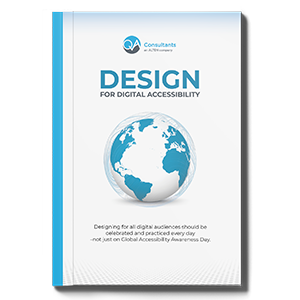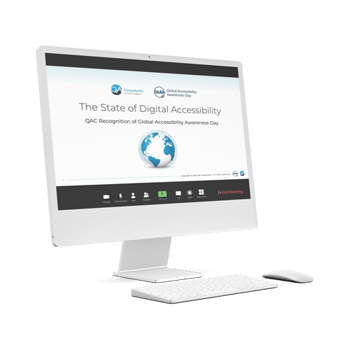
Designing for all digital audiences should be celebrated and practiced every day – not just on Global Accessibility Awareness Day.
In this spirit, we’re bringing awareness to inclusive design for websites, apps, software, and everything digital in between. QA Consultants (QAC) believes that accessibility is a significant part of the digital experience in today’s modern technology world. We try to drive more awareness to the role that technology plays in inclusion and deliver better products.

Impact of Not Being Digitally Accessible
$15.38 Billion USD
In Potential Lost Revenue Due to Abandonment
(World Health Organization)
2,058
Digital Accessibility Lawsuits Filed in 2020
(Accessibility.com)
$100,000 USD
Average Digital Accessibility Claim
(Accessibility.com)
15-46%
In Lost Market Share
(Gartner)
Not being digitally accessible has many negative impacts, including website abandonment, lawsuits, and lost market share. In fact, the World Health Organization calculates that an estimated $15.38 billion USD in revenue is lost each year due to website abandonment. Meanwhile, digital accessibility lawsuits have skyrocketed with Accessibilty.com noting 2,058 lawsuits were filed in 2020 with the average claim being $100,000. World-leading data research firm, Gartner, also estimates non-accessible websites lead to an estimated lost market share of 15-46%.
What is Digital Accessibility?
Digital accessibility refers to the ability of people with disabilities/impairments
to independently consume and/or interact with digital (e.g., web, mobile) applications and content (GAAD Website)
Explore why inclusive design and accessibility are important for your organization across all consumer, client, and employee-facing digital assets by downloading our tools custom-prepared for your use. Share these tools internally with your development teams, save them in a quick-access location for future use, implement the strategies proposed for an improved user experience with your digital products, and celebrate as a more inclusive audience experiences your brand.
Design for Digital Accessibility
Accessibility for all users across the digital landscape is no longer optional. Not only are government and regulatory agencies mandating minimum practices, but consumers – those with and without lived disabilities – are driving the demand for accessible websites, apps, software, and other digital products. This eBook examines the drivers behind inclusive design, accessibility, and what the future could hold for all organizations.


The State of Digital Accessibility
Originally delivered internally as a QA Consultants lunch and learn as part of Global Accessibility Awareness Day, this presentation evolved into a virtual webinar to bring awareness about inclusive design and accessibility across the digital landscape. It provides a high-level view of the importance of digital accessibility, the impacts of websites and apps that miss the mark, the latest trends and performance statistics, and recommendations for how all organizations can become more accessible-compliant with its own digital assets. Recorded from a live presentation on May 16, 2024, the webinar will be available to all audiences on-demand in the following days.
Why is Inclusive Design Important?
*as of 2020 (GAAD Website)
1 Billion
People Worldwide
Have Disabilities*
98.1%
Home Pages Have at Least One WCAG 2.0 Failure*
60.9
Average Number of
Errors per Home Page*
20%
(est.) of End Users
Have a Disability*
Inclusive design is important for an abundance of reasons – the primary being that nearly 1 billion people worldwide have disabilities. Yet, 98.1% of all Home pages have at least one WCAG 2.0 failure with a 60.9% average number of errors on the Home pages alone. For an audience where an estimated 20% of end users have a disability, the accessibility performance across the web landscape does not look promising.
Most Common Causes of Accessibility Failures
86.3%
Low Contrast Text
66%
Missing Image Alt Text
59.9%
Empty Links
53.8%
Missing Form Input Labels
28.7%
Empty Buttons
28%
Missing Document Language
When addressing website accessibility failures, there are dozens of reasons websites can fail compliance requirements. Some of the most common design culprits include: 86.3% due to low contrast text, 66% due to missing Image Alt text, 59.9% due to empty links, 53.8% due to missing form input labels, 28.7% due to empty buttons, and 28% of failures are contributed to missing document language.
Request a FREE Accessibility Assessment by filling out the form
Digital experience and the accessibility of web content is the epicenter where technology and DEI overlap. As an industry, we must continue to focus on moving the needle in helping organizations change and improve their ability to provide more inclusive workplaces through various forms of technology, ensuring more opportunities for potential employees, clients, and customers.
This assessment, conducted by our certified accessibility specialists, will enable an understanding of your WCAG 2.0 compliance.
(Terms: Limited up to 10 people/companies. Only one free assessment per person/company will be provided. Assessments are limited to a single page of one website for your organization and will be limited to the identification of up to 10 deficiencies. Assessments will be contracted and scheduled based on our accessibility engineers' availability.)
The QA Consultants Difference
Human-based accessibility assessments can’t be replaced by digital automation tools. Without actual human interaction and observation, organizations will not get a clear picture of how accessible its digital products are, putting compliance, reputation, sales, and the end user experience at risk. QA Consultants mitigates this risk with proprietary website automation testing tools, as well as dozens of certified digital accessibility specialists dedicated to setting your products up for success. From design through testing and post-launch, including inclusive design and accessibility testing performed by experienced QA professionals with lived disabilities, we aspire to make the internet an equal and accessible frontier.
WCAG Conformance Audits - WCAG Conformance Detailed Testing - User Experience Testing - Assistive Technology Functional Testing - WCAG Conformance Automation - Report Consulting - WCAG Conformance Education and Training Services - Voluntary Product Accessibility Template (VPAT) Preparation Services - SDLC Engagement Point Considerations - AODA Compliance - ADA Compliance
Trusted by Clients for Inclusivity Services since 2012

Other Resources
- Global Accessibility Awareness Day (GAAD)
- WebAIM
- WC3
- Accessibility for Ontarians with Disabilities Act
- WCAG 2.0 Checklist
- Americans with Disabilities Act of 1990 (ADA), as amended
- Section 504 of the U.S. Rehabilitation Act of 1973, as amended
- Section 508 of the Rehabilitation Act of 1973, as amended
- Canadian Human Rights Act - Policy on Communications and Federal Identity
- Accessibility for Ontarians with Disabilities Act, 2005
- Web and Mobile Accessibility Directive (EN 301 549)
Connect with Us
Connect with us on LinkedIn and share your stories about how accessibility design has impacted your daily life.
#QACGAAD24 #Accessibility #GAAD
Subscribe to QA Consultants Emails
About QA Consultants
QA Consultants (QAC) is North America's largest quality engineering firm and part of the ALTEN Group. For over 30 years, QAC has successfully delivered 12,000+ mission-critical projects across industries, including media, healthcare, government, insurance, energy, and more. QAC's award-winning services are sought after by quality, product development, and business application professionals who need to: improve the time to market of new and updated products or applications, reduce risk associated with software failures, and lower software product and/or app development costs. QAC's services, solutions, and products leverage current automation frameworks and tools to ensure your software applications: perform reliably under normal, unusual, and high-stress situations, conform to all security requirements, maintain data quality, comply with local or national accessibility standards, and utilize cost-efficient testing methods and tools.






